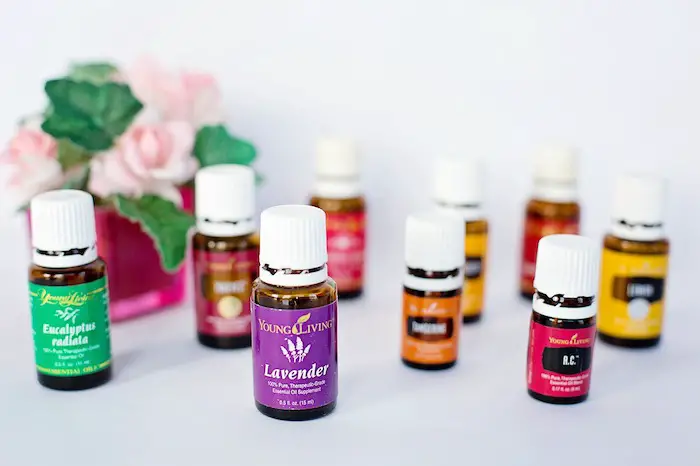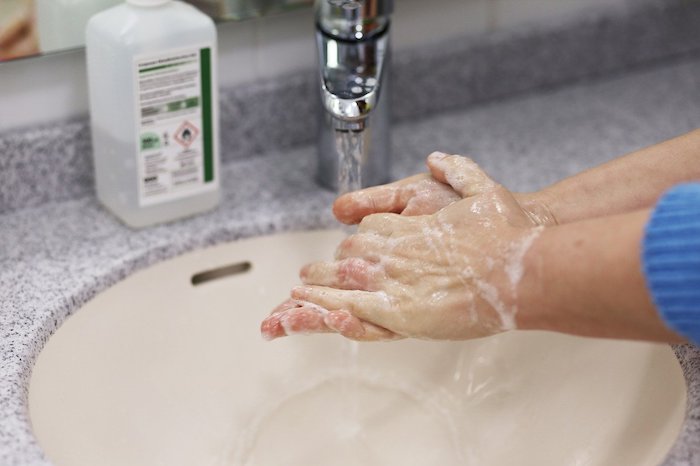It’s likely crossed your mind when you’ve hopped into the shower or bathtub only to discover that your body wash has run out, then found yourself looking over to the sink at the liquid hand soap or bar soap as a possible alternative for getting the job done. Or maybe you’ve gone to the store and noticed while buying hand soap that it could be purchased in significantly larger sizes or at a more reasonable price than what your usual body wash costs. Whether it’s in a hygiene emergency or for the sake of trying to save a bit of money, can you use hand soap to wash your body? Is that safe?
The answer is yes. However, hand soap is made of different ingredients than those used in body wash products. Therefore, the difference between these two cleaning products will most likely produce different results, especially depending upon your skin type.
Hand Soap vs. Body Wash Ingredients
Bar Hand Soap Ingredients
Bar hand soaps typically contain a combination of sodium hydroxide or lye, along with solid fats—such as palm oil or animal fats—that enable the bar to remain solid while in use, as well as when it is stored at room temperature. Bar soaps are able to clean your hands, but they often lack a very intense lather and focus more on maintaining their shape and consistency for long-term use.
Liquid Hand Soap Ingredients
Liquid hand soaps also typically contain sodium hydroxide. However, instead of containing solid fats, they often contain glycerin. This component is made from liquid fats, such as soybean oil, that help the soap remain in its liquid state. Additionally, antibacterial ingredients are then added to the liquid soap mixture to help kill bacteria as well as prevent fungus from growing within the container itself.
There are also liquid hand soaps that place an emphasis on being more rich and moisturizing. These, in addition to or in place of glycerin, contain added nourishing ingredients—such as essential oils, oatmeal, milk proteins, etc.—to help prevent or heal dry, cracked hands.
Body Wash Ingredients

Body wash is also usually made using the same process as liquid hand soap. However, instead of sodium hydroxide as the active ingredient, they often contain surfactants—such as sodium laureth sulfate (SLES), sodium lauryl sulfate(SLS)—which, because they help increase the distribution of oils and dirt in water, these help to penetrate, unbind, and capture unclean matter during the cleaning process so that it is washed away from the skin.
However, some body washes are also made using potassium hydroxide as an active ingredient. This ingredient, like sodium hydroxide, mixes with fat and oils, creating a chemical reaction called “saponification” that enables dirt and oils on the skin to be suspended and then washed away.
Hand Soap vs. Body Wash: Effects on the Skin
While trace amounts of sodium hydroxide and potassium hydroxide—which are both alkalis—in your hand soap are good for establishing the pH of the product, hand soaps that contain too much sodium hydroxide or potassium hydroxide can be highly acidic. This high acidity can damage or irritate the skin and cause it to sting or burn.
Furthermore, too high of an alkaline pH in your soap can strip your skin of its natural oils as well as damage the proteins in your skin, which can affect your skin’s structure.
This can also disrupt the skin’s acidic barrier, which protects against harmful bacteria and other contaminants, thus altering the skin’s microbiota (or “good bacteria”) as well as enzyme activity in the surface layers of the skin that have favorable pH. Yet again, this can also cause major damage to one’s skin. Frequent use of a soap like this will only further injure your skin.
Hand soaps that contain antibacterial properties can also destroy your skin’s protective microbiota layer, leaving your skin unhealthy and more susceptible to contaminants.
Therefore, while hand soaps may work well for your hands, they can be noticeable harsher and more drying on the rest of your body, especially when used on a regular basis.
On the other hand, body washes contain secondary surfactants as part of their ingredients. These help soothe the skin throughout the cleaning process, making body washes much gentler on the skin than hand soaps. They are also more pH-friendly since they generally do not contain alkalis, the lack of which helps prevent dry skin and skin damage as opposed to the stripping qualities of hand soaps.
Body washes also often contain added detergents as well. These provide a richer lather compared to hand soaps, providing you with a much more luxurious feel while cleaning with them.

Lastly, although unrelated to the ingredients and potential skin effects themselves, bar hand soaps are often viewed as being less hygienic overall due to the fact that the soap bars are often used by multiple people. This factor may make you question using it on your body, knowing that it’s unavoidably come into contact with so many other people. However, body wash squeezed straight from its own personal container enables you to enjoy fresh and untainted soap each and every use, so you’ll certainly feel better about using it on your skin.
How to Use Hand Soap as Body Wash
Should you still consider using hand soap as body wash, just be sure to look for a product that is free of sodium hydroxide and potassium hydroxide or that contains only a small amount of either ingredient. Neither sodium hydroxide nor potassium hydroxide should be listed as one of the first three ingredients on the product, so make sure of this first to avoid drying out and damaging your skin by using a harsh product.
Alternatively, you may also even consider making your own soap using full body-friendly ingredients. Making such a safe and versatile soap means that it can then be used as both hand soap and body wash. The following recipe is a great place to start when deciding which ingredients you want and learning how to make the soap yourself.
How to Make Your Own Bath Wash-Friendly Hand Soap
What You Will Need:
- 1 4-ounce bar of all-natural soap, such as Castile soap
- A cheese grater, potato peeler, or knife
- An essential oil of your choice
- Purified water
- A small boiling pot
- Liquid soap dispensers/bottles, about 4
Step 1: Turn the Bar into Soap Flakes
Grate, shave, or cut your 4-ounce bar of all-natural soap into fine flakes.
Natural soaps—such as Castile soap—are made using non-toxic, synthetic-free, and vegetable oil-based ingredients (such as coconut oil or castor oil) which are then incorporated along with almond oil, avocado oil, or walnut oil for lathering, moisturizing, and cleansing effects.
Step 2: Melt the Soap Flakes
Place the soap flakes into a bowl, then allow about eight cups of water to come to a boil. Turn off the heat, then pour the boiling water over the soap flakes. Use a large whisk or wooden spoon to melt the soap in the hot water.
Set the bowl aside and let the liquid soap cool for about 15 minutes. Next, stir the mixture again to further incorporate the ingredients and thicken the consistency of the liquid soap.
Step 3: Allow the Liquid Soap to Cool
Allow the liquid soap to cool in the bowl, covered, overnight or for at least 12 hours. Once the soap has fully congealed, if the soap is too thick, you can warm the soap and then add more water to thin it out a bit. If the liquid soap is too thin, warm the soap and then add more soap flakes to thicken it up.
Step 4: Add Essential Oils

Once you are satisfied with the consistency of the soap, next, add 15 to 20 drops of essential oil into the bowl. Some common essential oils include lemon, which is naturally anti-bacterial and helps improve skin, lavender, which provides calming and moisturizing effects, and peppermint, which is cooling on the skin and helps relieve itchiness.
Step 4: Pour the Liquid Soap into Dispensers or Bottles
Fill the dispensers or bottles of your choice with the liquid soap and then add the lids. Shake the containers to ensure that the ingredients are thoroughly mixed. Your homemade liquid soap can then be stored for up to a week or more.
Once you use the soap and rub it onto your hands or body, it should create a similar lather and cleaning experience as compared to traditional soap—just without all of the added chemicals normally found in those.
For a smoother and creamier consistency to your liquid soap, you may also try adding 1 cup of coconut milk to the hot soap mixture during preparation. This will also increase the nourishing effects of the soap and serve well for protecting your skin and keeping it soft.
Related Questions
When using homemade liquid soap to wash my hands, will it still have the same antibacterial effects as the store-bought antibacterial hand soaps?
Antibacterial hand soaps typically contain antibacterial ingredients, such as triclocarban or triclosan, which kill up to 99.9% of germs on the skin. However, antibacterial products are not actually needed to kill germs on one’s skin. In fact, according to the CDC, simply using water and soap is the best way to rid your hands of germs—provided you use the proper handwashing techniques, consisting of thoroughly scrubbing the palms, fingers, back of the hands, and under the nails for at least 20 seconds.
Therefore, yes, using homemade liquid hand soap to wash your hands will still provide the same germ-killing effects as an antibacterial hand soap, but it will do so without the harsh chemicals that can also disrupt your skin’s pH by destroying your skin’s helpful bacteria.
Can you add surfactants to homemade liquid soap?
It is possible to purchase both sodium lauryl sulfate (SLS) and sodium laureth sulfate (SLES) in some stores and online, and these can then be added to your homemade liquid soap to enhance its cleansing effects as well as its lathering capabilities for a more indulgent washing experience.
There are also green surfactants—such as decyl glucoside, coco glucoside, and cocamidopropyl betaine—which are often derived from palm oil, coconut oil, and sugar cane. These may be more suitable for sensitive skin.
Soap nuts and yucca extract can also be used to naturally create a rich lather, provided they are left to soak overnight or are boiled.
If you are out of hand soap, can you use body wash to wash your hands?
Perhaps, rather than running out of body wash, you have run out of hand soap and are wondering if you can use your body wash to wash your hands instead. Luckily, the answer is yes.
It is very much possible to use body wash to wash your hands, provided that you follow the CDC’s rules for properly washing your hands in the first place. This means that you should thoroughly wash all parts of your hands, including under your nails and between your fingers, for at least 20 seconds.
You may even find that your hands feel softer and more moisturized after washing with body wash, too, because those cleaners are often more pH-balanced and contain added ingredients to help soothe the skin since they’re typically used in more sensitive areas instead of just one’s hands.
Related Articles:
Can You Wash Clothes With Body Wash?
Can You Wash Your Hair With Hand Sanitizer?
Can You Wash Shoes With Clothes?
Can You Wash Clothes Twice In A Row?


